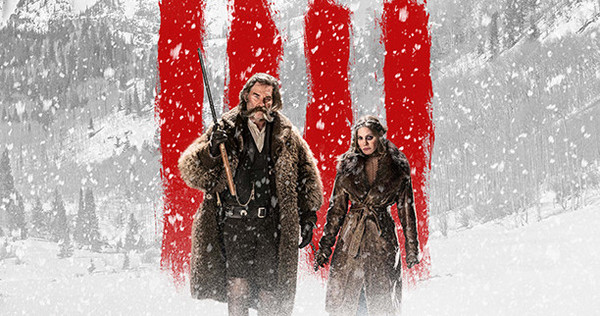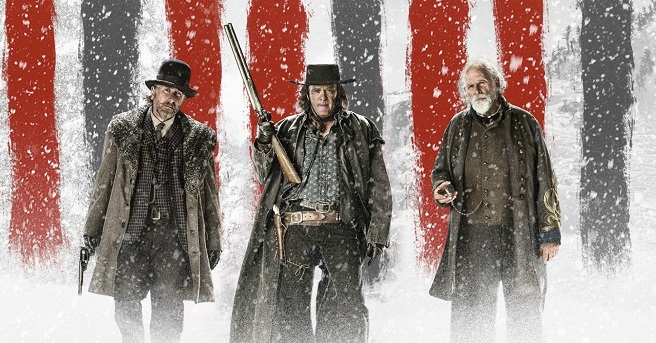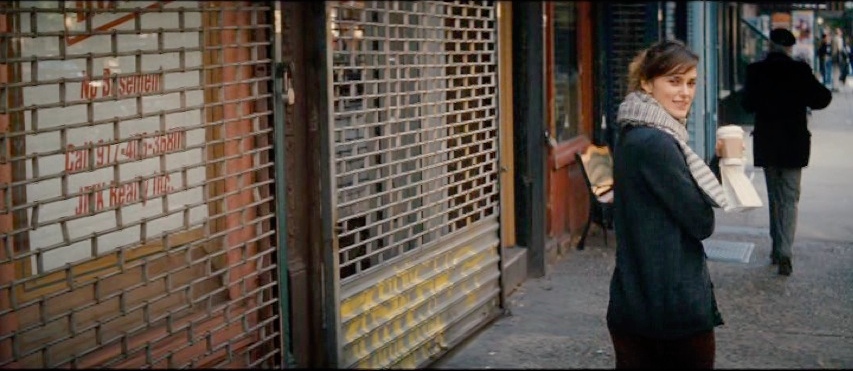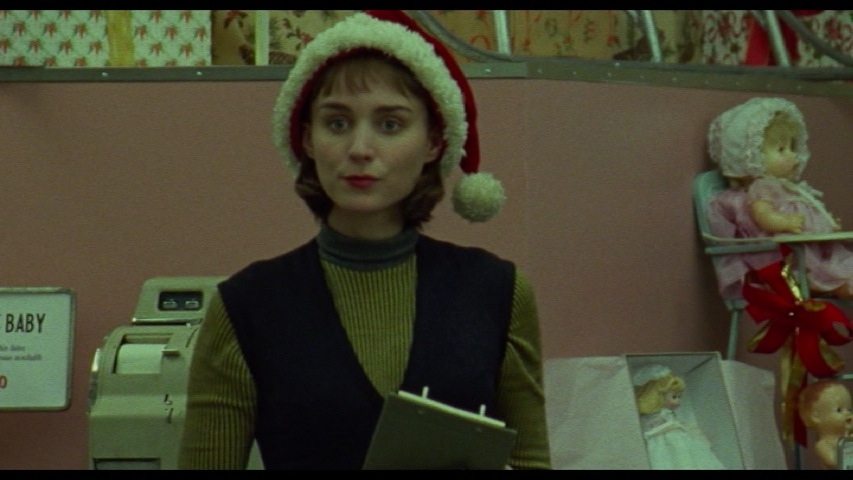« November 2015 | Main | January 2016 »
December 31, 2015
The Hateful 8

Quentin Tarantino - 2015
The Weinstein Company Digital 70 mm
The downside - I was originally planning to see The Hateful 8 at the first Christmas Day showing. I bought a ticket for the 11:40 am show as offered through Fandango. By chance, on Christmas Eve, I found out that someone at Regal Theaters decided that there would be no 11:40 am show. Of course it was too late to get a ticket for the 3:20 show which was sold out, and between being reliant on public transportation and having to work on Saturday, December 26, the only available show, starting after 10 pm was much too late to consider. Primarily because it was my next day off, I changed my ticket for the 11:40 am show on December 31.
The Regal Continental here in Denver has one of the biggest screens in town. Back when it was a single screen theater, I made a point of seeing several films in part to enjoy the scale of seeing movies on such a huge screen. That screen was given over to a space fantasy that has dominated most of the screens not only in the US but over the world. For those of us in Denver, the format for The Hateful 8 was digital 70 mm, shown in a smaller auditorium seating up to 274 people. The aspect ratio was correct, but the screen was too small for what Tarantino was visually trying to achieve in filming in Ultra Panavision 70. And even with a week's worth of past screenings, there were still a couple of glitches, a hiccup when the overture began, and the screen going dark during the last few minutes, temporarily making the audience wonder if we would see the film end correctly - eventually we did.

I made a point of seeing the 70 mm version because it seemed like an opportunity to be part of film history of sorts. Maybe not like being the first to see The Jazz Singer, for example, but because the choice of filming format and the insistence on the part of Tarantino to make a version that would be different from the "standard" version opening tomorrow, I figured I should make an effort to see what the fuss was about.
I sure as hell wish I saw The Hateful 8 on a giant screen, and maybe, just maybe, when "the force" dissipates, I'll be able to see Tarantino's film the way he wants it to be seen. That said, I like The Hateful 8 more than previous Tarantino films, probably because he's not trying so hard to cram in his references to other films. He's pushing it a bit with a character named Daisy Domergue, but it bothered me less that a general in Inglorious Basterds named Ed Fenech. And Jennifer Jason Leigh is so wonderful as the bad tempered, uncouth, scheming prisoner of Kurt Russell that she could have been named Daisy Duke for that matter. I wish I had seen her performance early enough for the Online Film Critics Society awards, but hopefully, those with later deadlines will acknowledge Leigh's performance.
I would have to disagree with those who call The Hateful 8 a western. I think it better to describe it as a post Civil War giallo. What makes me think of the film that was is the choice of music by Ennio Morricone. In addition to some original music, Tarantino has used music originally written for John Boorman's Exorcist II: The Heretic and John Carpenter's version of The Thing. It is significant that Tarantino chose note to reuse any of Morricone's scores for westerns. Even setting aside the well know work done for Sergio Leone, there were scores for the other Sergios - Corbucci and Sollima, as well as scores for Don Taylor's Five Man Army and Don Siegel's Two Mules for Sister Sara. Instead, Tarantino reuses music composed for two horror films.
In her study of the films by Dario Argento, Maitland McDonagh explains the origin giallo, originally used to describe crime novels published in Italy with yellow covers, many written by Agatha Christie. It does not seem coincidental, based on the basic plot and racial tensions in The Hateful 8, that the basic story is similar to Christie's And Then there were None, a book originally published in Britain with the title, Ten Little Niggers. Like the best giallo films, nobody and nothing is to be taken at face value in The Hateful 8, and almost everyone has a reason to be judged guilty.
Posted by Peter Nellhaus at 05:49 PM
December 27, 2015
Coffee Break

Keira Knightley in Last Night (Massy Tadjedin - 2010)
Posted by Peter Nellhaus at 07:18 AM
December 25, 2015
Merry Christmas!

Rooney Mara in Carol (Todd Haynes - 2015)
Posted by Peter Nellhaus at 08:57 AM
December 22, 2015
A Girl Walks Home Alone at Night

Ana Lily Amirpour - 2014
Kino Lorber BD Region A
Full disclosure here: I helped finance this movie. The Kickstarter campaign appeared on Facebook, and the premise of an Iranian Vampire Spaghetti western mishegoss of a film sounded interesting, to say the least. I tossed in a very modest amount, just enough to get a few emails letting me know that Amirpour has actually made her film, that it was playing the festival circuit, and was getting an actual theatrical release. Obviously, my investment paid off.
The blu-ray comes with several added supplements - deleted scenes, Amirpour discussing her film with Roger Corman, Amirpour and star Sheila Vand discussing the film with some guy from Vice, and a booklet with an essay from Erick Kohn of Indiewire. The booklet also comes with the "graphic novel", setting up the origin of "the girl" prior to her coming to Bad City, the imagined town where Girl takes place. And yet . . .
Some of the discussion adds insight into Amirpour's inspiration for making Girl. Most of the time, my feeling is one of "Cine Ipsa Loquitur', letting the film speak for itself. I think one of the most annoying aspects of Hollywood films is the need to explain things, especially with the comic book films and the fixation on "origin stories". Amirpour is confident enough that she let the audience figure out what's going on. Even though Amirpour has stated that Bad City is in an imaging Iran, it's also not impossible to visualize, as has happened in many American cities, a small town where everyone speaks Farsi. That we don't know where the vampire comes from or why she's in Bad City just adds to the mystery.
For me, the real tension in Girl has nothing to do with the horror genre aspects. The more palpable tension is cultural, a choice between Iranian tradition and a more western way of life. And none of the characters balance these choices in the same way. The young man, Arash, first seen cruising in his vintage Thunderbird, expresses concern about being alone in the same room as an unmarried young woman. The young woman is seen with a bandage on her nose suggesting that she may have had rhinoplasty, making her less obviously Middle Eastern facially. The girl, who is never named, dresses informally, somewhat reminiscent of Jean Seberg in Breathless, except when, out at night wearing the chador. The girl, as vampire, acts as the self appointed moral cop on the beat, sucking the blood out of a drug dealer, and scaring a young boy to stay on the straight and narrow. Amirpour has stated that her film came out the feeling of power she had skateboarding while wearing a chador, and with the cape of the chador flying in the wind, one of the film's most indelible images has been created.
In her discussion with Corman, Amirpour refers to her film as a fairy tale. Maybe not that big a stretch, as it made me think of Catherine Breillat's films inspired by the writings Charles Perrault, which teeter between fantasy and horror. Amirpour is aided in no small way by the black and white wide screen cinematography by Lyle Vincent. The shots of the oil derricks and run down houses filmed in Taft, California would be as fitting in classic film noir. The night here gets very black.

Posted by Peter Nellhaus at 05:43 PM
December 20, 2015
Coffee Break

Ann Sheridan in San Quentin (Lloyd Bacon - 1937)
Posted by Peter Nellhaus at 06:06 AM
December 15, 2015
Thundercrack!

Curt McDowell - 1975
Synapse Films BD Regions ABC
Following a reported five years of restoration work from the only complete print, Curt McDowell's cult film has finally been made available for home viewing. I did have the chance to see Thundercrack! theatrically in 1977, but from what I've read, it may have been just as well that I passed at that time. The version that played on the art house circuit may have been the 120 minute version, cut by the producers with no input from McDowell. Also, the quality of the sound, usually the weakest aspect of extremely low budget films, made parts of the dialogue unclear - and thankfully the Blu-ray comes with a choice of subtitles, including English for people like myself who try to be discrete, keeping the volume low especially when watching films loaded with sexual content.
Which brings up a much discussed point about Thundercrack! - is it art or porno or pornographic art? Even the legendary George Kuchar, McDowell's former teacher at the San Francisco Art Institute, who wrote the screenplay from a story by McDowell and Mark Ellinger, calls the film pornographic. The set-up is a parody of older films, a group of travelers are caught in a major rain storm, find shelter in the house of an older woman. Eventually, they are joined by a man driving a truck for a circus, carrying a lion, an elephant, and a gorilla. What transpires on everyone's part is an explosion of repressed libidos, and the graphic depiction of sexuality, primarily between consenting adults. George Kuchar was responsible for the most notorious coupling here, no doubt inspired by a screening in his youth of Curt Siodmak's Bride of the Gorilla from 1951. In this case, Kuchar plays the part of the bride.
On the down side, at 159 minutes, some of the jokes and double entendres wear thin with repetition. Apparently no one was willing to pare down any of the dialogue in Kuchar's screenplay. At its best, the black and white cinematography visually is reminiscent of Edgar G. Ulmer's films from the Forties, with the use of shadows, and filming people in close-ups in exterior scenes to disguise the absence of an actual set.
The Blu-ray comes with hilarious and essential documentary about George and Mike Kuchar, Jennifer Kroot's It Came from Kuchar, made in 2009, two years before George's death. It appears that there was an earlier effort to make Thundercrack! available, as the supplemental DVD has footage of star Marion Eaton, writer/composer Mark Ellinger, and self-shot video from George Kuchar, all from 2004. There is also a selection of several short films by Curt McDowell, all but one, "Loads", made prior to Thundercrack!, with the musical, "Boggy Depot" highly recommended.
Posted by Peter Nellhaus at 03:03 PM
December 13, 2015
Coffee Break

Rachel Weisz in The Bourne Legacy (Tony Gilroy - 2012)
Posted by Peter Nellhaus at 06:09 AM
December 08, 2015
The Crooked Way

Robert Florey - 1949
KL Studio Classics BD Region A
Sonny Tufts?
Believe it! Only a year older than John Payne, there should be no problem with Tufts as the long-time former friend who grew up with Payne. Maybe it was the effects of reported alcoholism, but Tufts does look at least ten years older, with his creased face, with the black and white cinematography making his blond hair appear prematurely white. The voice is as smooth as sandpaper. As the gangster, Vince Alexander, Tufts is eminently effective here, making life miserable for those he sees as standing in his way.
John Payne plays a former G.I., Eddie Rice, released from a military hospital. Shrapnel in the skull has caused amnesia, and with the doctors seeing no cure for the memory loss, Rice is released, headed to Los Angeles, his last known address. In Los Angeles, Rice quickly finds out that he's been known as Eddie Riccardi, a criminal associated with Vince Alexander. The more that is uncovered about Eddie Riccardi, the more Eddie Rice learns the hard way that ignorance is bliss.
As a genre exercise, The Crooked Way is an almost perfect example of Film Noir. The central character is a loner, dislocated from his past, alone in a big, imposing, city. The main nemeses is a very organized man, shielded by wealth, a legitimate business to cover the illegal activities, and if needed, hired muscle if force is needed. The exception may be in Ellen Drew's character of Nina Martin. Nina is not quite the femme fatale, only putting Eddie's life in danger somewhat reluctantly, based on her past relationship, one that Eddie does not remember.
Visually, this is the stuff that Film Noir dreams are made of. There are more than enough visual flourishes here. Sharing the frame are extreme close-ups in the foreground, with lesser characters standing in the back. There are shadowy people in a shadowy world. A nice touch includes the oversized shadow of the railing leading up to Eddie's hotel room. Hunted down by Tufts, Payne and Drew are seen as silhouettes in a darkened house. At a later point, Robert Florey cuts between close-ups of Drew, her face illuminated, and Payne, his face in the dark, a shadow of himself, unlit save for faint backlight providing an outline.
From Thomas Pryor's review in the New York Times: "The Crooked Way" races along as a melodrama should and it has more than enough plot to keep its hard-working actors going from one dangerous situation to another. But there is so much pointless brutality in it that one may seriously question whether the movie people are wise to go on with the making of such pictures. The human family may not be perfect, but why subject it to so-called entertainment that is only fit for savage beasts.
Be that as it may, contemporary viewers may well get a bit of a jolt when after being beaten senseless by a trio of gangsters, Payne is tossed down the stairway of a fire escape. As an example of classic Film Noir, that's entertainment.

Posted by Peter Nellhaus at 04:23 AM
December 06, 2015
Coffee Break

Kristen Stewart in Clouds of Sils Maria (Olivier Assayas - 2014)
Posted by Peter Nellhaus at 02:53 PM
December 01, 2015
Assassination

Amsal
Choi Dong-hoon - 2015
Well Go USA Entertainment BD Region A
What ever one might think of Choi Dong-hoon, I don't think he will ever be accused of being understated in his films. Choi's films are chockablock full of spectacular set pieces. So it is with Assassination, the historically inspired story that takes place primarily during the time of Japan's occupation of Korea.
Choi's previous film was The Thieves, the wonderful pan-Asian heist movie from 2012. Choi tries something as ambitious here. What gets in the way is that even with some knowledge of the history taking place, there are times when I felt the need for a score card to remind myself of which side some of the characters belonged to in the fight for Korean independence. As it is, the one part of the story that was a variation of The Corsican Brothers, with female twins separated following the assassination attempt of their father, was the least confusing part of this film.
Until the second half of the film, Choi mixes up comedy with adventure, with three disgraced rebels are assigned to kill a Japanese official and one of the leading Korean collaborators. The story hops from Manchuria to Shanghai, and finally to Seoul. It is made clear later why three unlikely persons were chosen for this assignment. The comic elements come in with the different playings of identity, primarily of the Korean characters navigating their way through Japanese territory. Further adding to the complications is the knowledge that there are rival factions of groups fighting for Korean independence, as well as persons who may be acting as double agents.
Among the three rebels in Ok-yun, a young woman and sniper who may or may not have deliberately shot her superior officer. Except for one brief moment when we see guns strapped to Ok-yun's thigh, Choi has chosen not to play up Jun's attractiveness, instead emphasizing the seriousness of Ok-yun, even as she samples coffee for the first time at French hotel in Shanghai. Jun is also in the most tragic scenes, in which the destruction of a family may well be representative of what happened to a country.
With all of the shooting, explosions and assorted mayhem, it is also to Choi's credit that the best scene, or more accurately, the most satisfying scene, is near the end, when the identity of the Korean rebel working for the Japanese is revealed. Identified and shot, revenge having no time limit even after Korean independence, the man staggers away from the camera, framed by two lines of laundry, white sheets, on the right and left side of the screen. The camera views that action without dramatic emphasis. After almost two hours of blood and bullets, Choi Dong-hoon also knows when to stand back.

Posted by Peter Nellhaus at 02:46 PM
